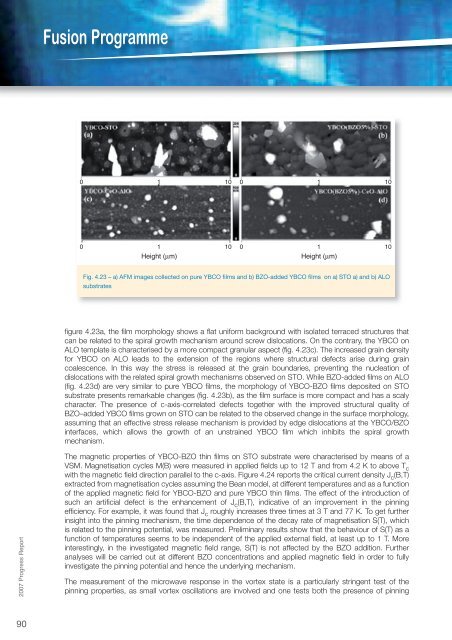Fusion Programme - ENEA - Fusione
Fusion Programme - ENEA - Fusione
Fusion Programme - ENEA - Fusione
- No tags were found...
You also want an ePaper? Increase the reach of your titles
YUMPU automatically turns print PDFs into web optimized ePapers that Google loves.
<strong>Fusion</strong> <strong>Programme</strong>0 1 10 0 1 100 1 10Height (μm)0 1 10Height (μm)Fig. 4.23 – a) AFM images collected on pure YBCO films and b) BZO-added YBCO films on a) STO a) and b) ALOsubstratesfigure 4.23a, the film morphology shows a flat uniform background with isolated terraced structures thatcan be related to the spiral growth mechanism around screw dislocations. On the contrary, the YBCO onALO template is characterised by a more compact granular aspect (fig. 4.23c). The increased grain densityfor YBCO on ALO leads to the extension of the regions where structural defects arise during graincoalescence. In this way the stress is released at the grain boundaries, preventing the nucleation ofdislocations with the related spiral growth mechanisms observed on STO. While BZO-added films on ALO(fig. 4.23d) are very similar to pure YBCO films, the morphology of YBCO-BZO films deposited on STOsubstrate presents remarkable changes (fig. 4.23b), as the film surface is more compact and has a scalycharacter. The presence of c-axis-correlated defects together with the improved structural quality ofBZO–added YBCO films grown on STO can be related to the observed change in the surface morphology,assuming that an effective stress release mechanism is provided by edge dislocations at the YBCO/BZOinterfaces, which allows the growth of an unstrained YBCO film which inhibits the spiral growthmechanism.2007 Progress ReportThe magnetic properties of YBCO-BZO thin films on STO substrate were characterised by means of aVSM. Magnetisation cycles M(B) were measured in applied fields up to 12 T and from 4.2 K to above T cwith the magnetic field direction parallel to the c-axis. Figure 4.24 reports the critical current density J c (B,T)extracted from magnetisation cycles assuming the Bean model, at different temperatures and as a functionof the applied magnetic field for YBCO-BZO and pure YBCO thin films. The effect of the introduction ofsuch an artificial defect is the enhancement of J c (B,T), indicative of an improvement in the pinningefficiency. For example, it was found that J c roughly increases three times at 3 T and 77 K. To get furtherinsight into the pinning mechanism, the time dependence of the decay rate of magnetisation S(T), whichis related to the pinning potential, was measured. Preliminary results show that the behaviour of S(T) as afunction of temperatures seems to be independent of the applied external field, at least up to 1 T. Moreinterestingly, in the investigated magnetic field range, S(T) is not affected by the BZO addition. Furtheranalyses will be carried out at different BZO concentrations and applied magnetic field in order to fullyinvestigate the pinning potential and hence the underlying mechanism.The measurement of the microwave response in the vortex state is a particularly stringent test of thepinning properties, as small vortex oscillations are involved and one tests both the presence of pinning90













